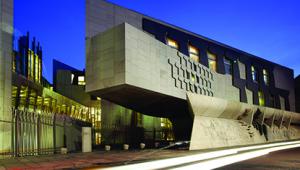As Scotland looks ahead to Holyrood elections in May and the possibility of a new party in power, many are asking whether it is time Labour and the SNP recognised their similarities
There’s an unmistakable pre-election air to Scottish politics right now, as the voters prepare to cast their verdict on the four-year experiment in Scottish National Party government. It has been experimental in two respects: the first ever administration run by nationalists in the UK, and the first mainland minority government.
Alex Salmond, with his largely social democratic policy agenda, has managed to cling on to power for four years, with only 47 out of 129 MSPs.
Quite a feat. But if the opinion polls are any guide, the Labour leader Iain Gray will be taking over in Holyrood after the election in May.
However, things might not change very much, for Gray is also likely to be running a Left-of-centre minority administration. He has ruled out any coalition with the SNP or the Scottish Conservatives – and, given the Liberal Democrat coalition with the Conservatives in Westminster, is unlikely to want Tavish Scott, the Scottish LibDem leader, sitting next to him as deputy first minister.
This means that Gray, like Salmond, will have to rely on the other parties to get his legislation, and most importantly his budgets, through the Scottish Parliament.
Now, Labour and the SNP are bitter political enemies, but they actually disagree about remarkably little. The nationalists want to leave the UK, of course, but independence is not really an issue in Scotland at the moment. Salmond abandoned the Bill for a referendum on independence when he realised it would get little support. The first minister has explicitly sought to run a devolved administration within the constitutional status quo and has not sought to destabilise relations with London. Well, not much.
In other respects, both Gray and Salmond are peas out of the same social democratic pod. They both reject market reforms to the NHS, support comprehensive education and agree that the deficit reduction programme is too much too fast. About the only serious policy difference is over university tuition fees, and even here there is more that unites the parties than divides them. They both want an essentially taxpayer-funded university system, and reject the £9,000 fee cap – though Labour is more keen on a graduate contribution from students.
So narrow is the policy divide that Labour has been struggling to find issues to throw at Salmond at Question Time, relying on snow-blocked roads, pot holes and a levy on out-of-town supermarkets. Not exactly momentous matters of state. A number of people within ‘civic’ Scotland are asking if it isn’t time the two parties tried working together. After all, there is clearly a national emergency: the economy is failing to recover in Scotland, and public spending cuts are now beginning to seriously affect employment.
Look at Wales, say the critics of political tribalism. There, Labour and the nationalist Plaid Cymru have been in coalition and seem to be getting on pretty well. They united on greater powers for the Cardiff Assembly, are working for a ‘yes’ in the referendum in March and have refused to allow Welsh universities to charge £9,000 fees. If Labour and the SNP could work together, critics say, the Scottish Parliament could be a lot more effective in promoting Scotland’s interests.
But I fear it will be a cold day in hell when the SNP and Labour put aside their differences. The forthcoming election campaign will show that. Scotland’s parties are like rival gangs, who live to fight – there’s simply no stopping them.
Iain Macwhirter is political commentator on the Sunday Herald










